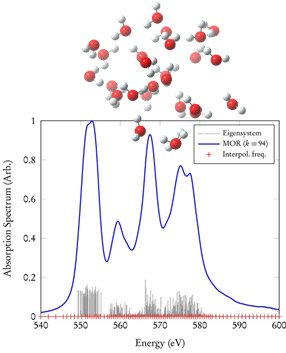Computing X-ray Absorption Near Edge Spectra of Condensed Matter
Published: March 23, 2020

X-ray absorption spectroscopy (XAS) is now an essential tool for condensed matter chemical physics. The ability of XAS to simultaneously characterize both the electronic and geometrical structure of chemical systems has made it indispensable in the fields of catalysis and photophysics. However, the complexity of the experimental data often requires a theoretical basis for interpretation of the results, especially in situations of energetically dense orbital interactions. Exact solutions can be calculated, but require a significant investment of computational resources.
In a collaboration between the IDREAM Energy Frontier Research Center and the Lawrence Berkeley National Laboratory Frameworks, Algorithms, and Scalable Technologies for Mathematics (FASTMath) Scientific Discovery through Advanced Computing Center, researchers have developed a new approach called Model Order Reduction (MOR) that reduces the computational complexity and speeds generation of the result. MOR is a novel, adaptive algorithm that uses interpolation to reduce the computational complexity associated with ab initio prediction of the absorption spectrum without a noticeable reduction in accuracy. MOR overcomes the large computational overhead associated with the spectral discretization required by linear system based methods while maintaining the accuracy associated with eigenproblem-based methods. Further, the proposed algorithm allows for the massively scalable parallelism that is well suited for modern computing architectures.
Acknowledgments
Sponsors: This work was partly supported by the Scientific Discovery through Advanced Computing (SciDAC) program (R.V.B., C. Y. and E.G.N.) and the IDREAM Energy Frontier Research Center (D.B.W.Y., J.M.K., and X.L.), funded by the U.S. Department of Energy, Office of Science, Advanced Scientific Computing Research and Basic Energy Sciences. R.V.B. is a Postdoctoral Fellow of the Research Foundation-Flanders. The development of the Chronus Quantum software is supported by the National Science Foundation.
Facilities: National Energy Research Scientific Computing (NERSC) Center, a DOE scientific user facility, and the Hyak supercomputer system at the University of Washington
Research team: Roel Van Beeumen, Chao Yang, and Esmond G. Ng, Lawrence Berkeley National Laboratory; David B. Williams-Young, Joseph M. Kasper, and Xiaosong Li, University of Washington
Reference: Van Beeumen R, DB Williams-Young, JM Kasper, C Yang, EG Ng, and X Li. 2017. "Model Order Reduction Algorithm for Estimating the Absorption Spectrum." Journal of Chemical Theory and Computation 13(10):4950-4961. DOI: 10.1021/acs.jctc.7b00402
Published: March 23, 2020